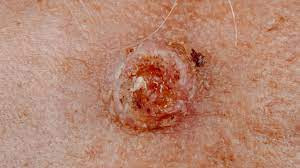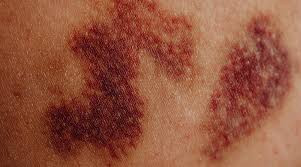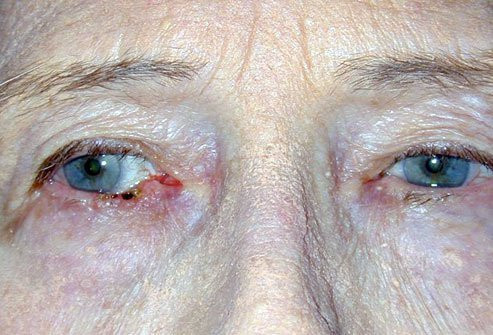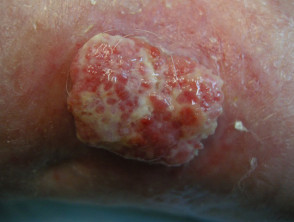Definition
Squamous cell carcinoma (SCC) of the skin is the second most common type of skin cancer. It is characterized by rapid and abnormal growth of the squamous cells. Squamous cells are one of the three main cell types in the upper layer of the skin (epidermis). They are located near the skin's surface and constantly slough off as new skin cells regenerate.
While this type of skin cancer is generally not life-threatening, it can still be aggressive. If left untreated, squamous cell carcinoma can get bigger or spread to other parts of the body, causing serious complications.
The number of cases of this skin cancer is increasing in the last three decades. In the United States, for example, it is estimated that 1.8 million cases of squamous cell carcinoma are diagnosed each year.
Causes
SCC occurs when the DNA of the skin's squamous cells is damaged or mutated. The DNA of the cell regulates its life. Damage or mutation to the DNA of squamous cells in the skin can cause them to grow uncontrollably and not undergo cell death like other normal cells.
Some DNA damage occurs due to long-term skin exposure to ultraviolet radiation or other damaging substances. Exposure to ultraviolet radiation can be obtained from sunlight, tanning beds, or lamps. It triggers abnormal changes in the skin's squamous cells.
However, this theory does not explain why squamous cell carcinoma develops on areas of the skin that are not normally exposed to sunlight. This implies that other factors contribute to the formation of skin cancer, such as the presence of other conditions in the patient that suppress their immune system.
Risk factor
SCC is quite common in older men, so it is suspected that the older male gender is one of the risk factors. However, it can also occur in women and young adults. In addition, smoking can also increase a person's risk of developing squamous cell carcinoma.
Excessive exposure to ultraviolet light, which comes from sunlight and tanning beds, is also a risk factor for skin SCC. Spending a lot of time in the sun, especially if you do not cover your skin with clothing or use sunscreen, increases your risk of developing this particular skin cancer.
Another risk factor is having a light skin tone. All people with any skin tone can suffer from squamous cell carcinoma. However, light-skinned people have less skin pigment (melanin) and less protection against ultraviolet radiation. If you have blonde or red hair, a bright iris color, are easily sunburned, or have freckles on your face, you are more likely to develop skin cancer, including squamous cell carcinoma, than darker skin.
Other factors that may increase a person's risk of developing squamous cell carcinoma of the skin are:
- A history of having a precancerous skin condition, such as actinic keratosis or Bowen's disease
- Previous skin injuries such as burns, leg ulcers, or cutaneous lupus
- Previous history of skin cancer, if you have had SCC or other skin cancers such as melanoma or basal cell carcinoma of the skin, then you are more likely to develop SCC
- A weakened immune system can increase the risk of skin cancer, for example in:
- People with leukemia or lymphoma
- Currently using immunosuppressive drugs
- People who have undergone organ transplants
- Exposure to arsenic
- Certain genetic disorders, for example, people with xeroderma pigmentosum have extreme sensitivity to sunlight, making them more susceptible to skin cancer
Symptoms
Squamous cells are found throughout the body, and SCC can occur in any part where squamous cells are present. SCC is most common on sun-exposed body areas, such as the scalp, back of the hands, ears, and lips. However, it can also occur in other body areas, including the mouth, feet, and genital area. It may cause itching, bleeding, or the formation of scabs.
The symptoms of skin SCC may vary in each person. Squamous cell carcinoma of the skin can appear as scaly red patches, scabs, or reddish hard lumps with a depression in the center. These skin abnormalities are typically painful and may bleed. The lump or patch may grow in size over several weeks or months. The size of the skin disorder varies, with diameters ranging from a few millimeters to a few centimeters.
Diagnosis
When your doctor sees your skin disorder for the first time, he or she will ask detailed questions about the condition and your medical history. If the doctor suspects your skin disorder is a malignancy or skin cancer, he or she will recommend additional tests to confirm the diagnosis.
One of the additional tests that can be done is a skin biopsy. A skin biopsy is performed by taking some or all of the samples of the skin area suspected of being cancerous. The tissue sample will be sent to the laboratory to be examined under a microscope.
In patients at high risk of squamous cell carcinoma, the doctor may suggest other tests to determine whether the cancer has spread to the lymph nodes or other body parts. Tests that can be performed include:
- Imaging tests such as ultrasound, X-rays, CT scans, and MRIs.
- Biopsy of lymph nodes or other tissues
Management
If diagnosed early, squamous cell carcinoma can be cured. In general, SCC can be removed with a minor surgical procedure. Treatment options depend on the size, location, aggressiveness of the tumor, and your preference.
- Treatments for a very small SCC with a low risk of spread are:
- Curettage and electrodesiccation (electrosurgery)
- Laser therapy
- Freeze surgery
- Photodynamic therapy
- Treatment for large SCC:
- Surgery to remove cancer
- Mohs surgery
- Radiation therapy
- Treatment for SCC that has spread:
- Chemotherapy
- Targeted drug therapy
- Immunotherapy
Complications
Most squamous cell carcinomas are easily treated and have a high success rate. However, untreated SCC can become aggressive and spread to other body parts, such as the lymph nodes or other organs. This can disrupt the body's shape, damage surrounding healthy tissue, and become fatal or life-threatening.
The risk of aggressive SCC increases when:
- The cancer is large or deeply located
- The cancer involves mucous membranes such as the lips
- The cancer occurs in people with weakened immune systems
Prevention
Most skin SCC can be prevented by:
- Avoiding the central midday sun. The sun's rays are strongest from 10 am to 3 pm, so being outdoors during this time is not advisable.
- Wear sunscreen throughout the season. A broad-spectrum sunscreen with at least SPF 30 is highly recommended, including when the weather is cloudy or overcast. Apply sunscreen liberally and reapply every two hours if you are exposed to water or sweating.
- Wear protective clothing. Cover your skin with dark, tightly woven clothing. Cover your arms and legs, and wear a wide-brimmed hat that protects the scalp and face. Don't forget to wear UVA—and UVB-resistant sunglasses.
- Avoid tanning beds. Tanning beds emit ultraviolet waves.
- Do regular skin checks and consult a doctor if there are any changes in your skin. Check your skin and look for any lumps or unusual changes in moles, freckles, and other skin conditions.
When to see a doctor?
You should consult a doctor or skin specialist if you have sores or scabs that do not heal within two months, or have scaly patches that do not go away.
Looking for more information about other diseases? Click here!
- dr Hanifa Rahma
Squamous Cell Carcinoma. The Skin Cancer Foundation. (2022). Retrieved 24 May 2022, from https://www.skincancer.org/skin-cancer-information/squamous-cell-carcinoma/.
Squamous cell carcinoma of the skin - Diagnosis and treatment - Mayo Clinic. Mayoclinic.org. (2022). Retrieved 24 May 2022, from https://www.mayoclinic.org/diseases-conditions/squamous-cell-carcinoma/diagnosis-treatment/drc-20352486.
Cutaneous squamous cell carcinoma: Symptoms, Causes, and Treatment — DermNet. Dermnetnz.org. (2022). Retrieved 24 May 2022, from https://dermnetnz.org/topics/cutaneous-squamous-cell-carcinoma.












